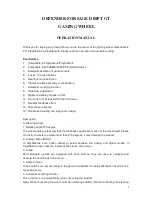
28467 Rev I
10
02-02
NOVUS TOP DV GAS APPLIANCE INSTALLATION INSTRUCTIONS
e. Termination
Vent termination must not be recessed in the wall or siding. Siding may be brought to the edge of the cap
base.
Install the cap as shown in Figure 12. Cap pipe sections should overlap the vent pipe by 1½ inches. Caulk
outside edges of cap.
Local codes may require the installation of a shield which prevents the cap from accidentally touching
anything or anyone.
Figure 13 illustrates cap locations prescribed by current ANSI Z273.1 and CAN/CGA-B149 Installation
Codes.
Figure 13 - Termination Cap Locations
Dimension Descriptions
A
Clearance above the ground, a veranda, porch, deck or
balcony - 12 inches (30 cm) minimum. *
B
Clearance to window or door that may be opened 10,000
BTUs or less, 6 inches (15 cm) minimum; 10,000-50,000
BTUs, 9 inches (23 cm) minimum; over 50,000 BTUs, 12
inches (30 cm) minimum. *
C
Clearance to permanently closed window 12 inches (30
cm) minimum - recommended to prevent condensation on
window.
D
Vertical clearance to ventilated soffit located above the
termination within a horizontal distance of 2 feet (60 cm)
from the centerline of the termination 18 inches (46 cm)
minimum. **
E
Vertical clearance to unventilated soffit - 12 inches (30 cm)
minimum. **
F
Clearance to outside corner - 6 inches (15 cm) minimum.
G
Clearance to inside corner - 6 inches (15 cm) minimum.
H
Not to be installed above a meter/regulator assembly within
3 feet (90 cm) horizontally* from the center line of the regulator
I
Clearance to service regulator vent outlet - 6 feet (1.8m)
minimum. *
J
Clearance to non-mechanical air supply inlet into building or
the combustion air inlet to any other appliance - 12 inches
(30 cm) minimum. *
K
Clearance to mechanical air supply inlet - 6 feet (1.8 m)
minimum. *
L
Clearance above a paved sidewalk or paved driveway
located on public property - 7 feet (2.1 m) minimum.
A vent may not terminate directly above a sidewalk or paved
driveway which is located between two single family
dwellings and serves both dwellings.
M
Clearance under veranda, porch, deck or balcony - 12 inches
(30 cm) minimum. * Recommended 30 inches (76 cm) for
vinyl or plastic.
Only permitted if veranda, porch, deck or balcony is fully
open on a minimum of 2 sides beneath the floor. *
N
Vertical clearance between two horizontal termination caps
12 inches (30 cm) minimum.
O
Horizontal clearance between two horizontal termination
caps 12 inches (30 cm) minimum.
*
As specified in CGA B149 Installation Codes
Note: Local codes or regulations may require different
clearances.
**
Clearance required to vinyl soffit material 30 inches (76
cm) minimum. With a vinyl soffit shield 18 inches (46 cm)
minimum.
WARNING!
In the U.S.:
Vent system termination is NOT permitted in
screened porches. You must follow side wall, overhang
and ground clearances as stated in the instructions.
In Canada:
Vent system termination is NOT permitted in
screened porches. Vent system termination is permitted in
porch areas with two or more sides open. You must follow
all side wall, overhang and ground clearances as stated in
the instructions.
Hearth Technologies Inc. assumes no responsibility for the
improper performance of the appliance when the venting
system does not meet these requirements.
All manuals and user guides at all-guides.com











































